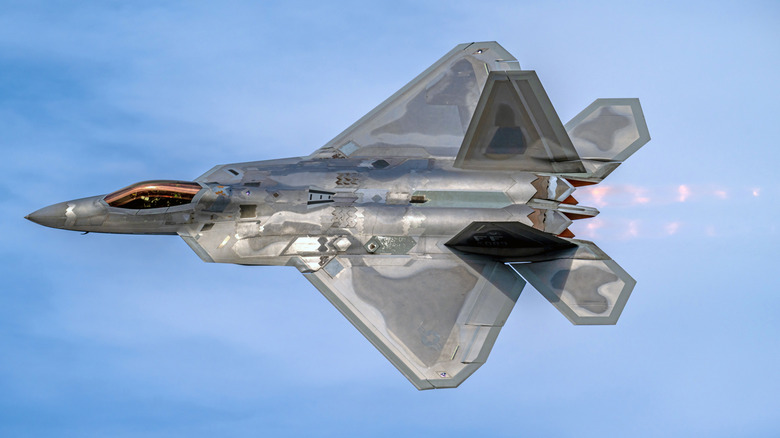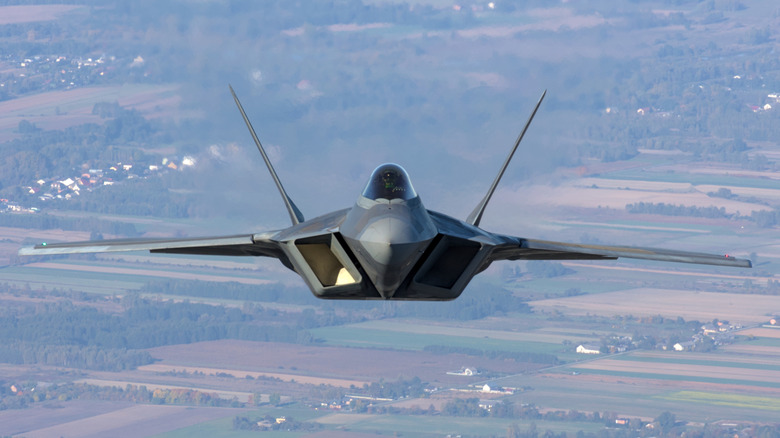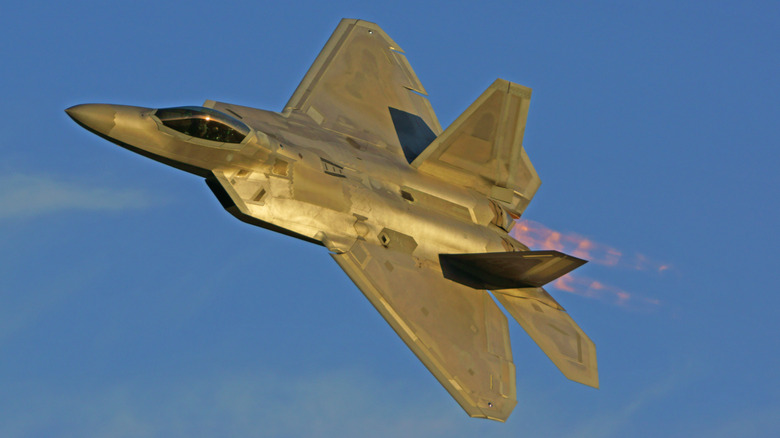The Jet Fighter So Advanced That US Law Bans It From Being Exported
It's well known that the United States has the largest budget for defense spending on the planet. The U.S. spends more than the next nine nations combined, but that's for the nation's six military branches. Outside the U.S., defense contractors sell arms and armaments to other nations around the world (with government permission), and the U.S. is no different. In fact, the U.S. is the largest arms exporter on the planet.
The nation's world defense market share is just over 40%, so the U.S. doesn't mess around when it comes to selling weapons systems to its allies. These include everything from the M1 Abrams Main Battle tank and the F-16 Fighting Falcon to the incredibly advanced fifth-generation fighter, the F-35 Lightning II, and a variety of other active and passive defense systems. Despite sending its most advanced aircraft and armored systems to other nations, there's one piece of equipment that the U.S. doesn't export: The F-22 Raptor.
The F-22 is a supercruise fighter with incredible capabilities, and it's also the world's first fifth-generation fighter. It's so highly advanced that most of its capabilities are classified as Top Secret, and because of this and other reasons, the U.S. absolutely forbids its export to any nation in the world, allies or not. One of the fighter's most significant technologies keeping its sales from happening revolves around its stealth capabilities, and it's all because of a law signed in 1998.
Congress blocks the sale of the F-22
In 1998, the 98th Congress passed an amendment to H.R. 2266, which, under section 8117, absolutely forbids the approval or licensing for "The sale of the F-22 advanced tactical fighter to any foreign government." That single line of text is the legal action that ensures the F-22 isn't sold to a foreign nation, but the bill doesn't explain why Congress took this action. In 2009, the Senate made a move to develop an exportable version of the F-22, but H.R. 2266 forbade moving forward.
Despite the ban, it was still considered, and The War Zone got a copy of the U.S. Air Force's export feasibility project, estimating the cost of developing such an exportable fighter. Had the U.S. moved forward with the plan, it would have cost around $13 billion, though it's unclear how much sales of such a fighter would have brought into the States. The proposed fighter would have required the replacement of most of its advanced systems, the majority of which are highly classified and redacted in official documents.
Despite the interest in purchasing the aircraft by American allies, the F-22 is no longer being manufactured. The program ended in 2011 in favor of the more advanced F-35, which costs less to produce and is more versatile. All told, only 195 of the planned 750 F-22s were ever built, but the interest in their potential availability has never fully waned. Despite its issues and incredible cost, the F-22 remains a formidable aircraft with unmatched capabilities found in fifth-generation fighters.
Why the F-22 is so desirable but the U.S.' allies
The F-22 was designed to replace the F-15 Eagle as the U.S.' newest air superiority fighter. It features sensors that enable widespread situational awareness in an aircraft that is highly maneuverable and incredibly fast. Its top speed is above Mach 2.0 (1,535 mph), but it also has a supercruise feature, and without afterburners, it can cruise at speeds in excess of Mach 1.5 (1,151 mph). That feature makes the F-22 almost impossible to catch in a dogfight.
It has thrust vectoring capabilities that can push 35,000 lbs. of thrust in each of its two Pratt & Whitney F119-PW-100 turbofan engines. In terms of weapons systems, there's a lot of strength packed inside the F-22, which has three internal weapons bays capable of carrying two AIM-9 Sidewinder air-to-air missiles and six AIM-120 AMRAAM radar-guided missiles. It can also carry two 1,000 lb. GBU-32 JDAM bombs or eight small diameter bombs. It also boasts an M61A2 20mm cannon.
Because these are carried internally, they don't interfere with the aircraft's stealth capabilities, making the F-22 incredibly desirable as an air superiority fighter. While it's certainly got what it takes to win in a dogfight and take out targets on the ground, the F-22 will likely never be sold, seeing as the only operational aircraft are actively in use by the U.S. Air Force, which is prohibited from selling them at any time unless Congress changes the law it passed in 1998.


